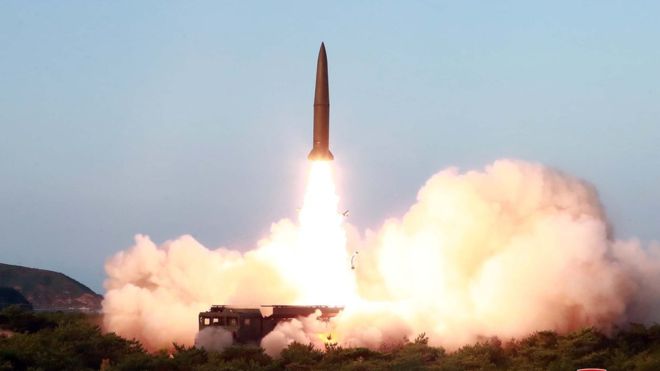North Korea has called the test of two new missiles on Thursday a “solemn warning” against what it described as “South Korean warmongers”.
The short-range missiles were fired into the Sea of Japan, also known as the East Sea, from Wonsan on North Korea’s east coast.
Leader Kim Jong-un said his country was forced to develop weapons to “eliminate potential and direct threats”.
He said the test involved a new tactical guided weapons system.
Mr Kim’s comments, reported in state media, come after the North criticised a decision by South Korea and the US to hold military drills next month.
North Korea has long regarded the drills as preparation for an invasion.
Though the US and South Korea have refused to cancel the annual military exercises, they have been scaled back significantly.
South Korea’s Joint Chiefs of Staff (JCS) said one of the new missiles travelled about 690km (428 miles). The US also confirmed that the missiles were “short-range”.
What did Kim Jong-un say?
Mr Kim said he was “satisfied” with the new weapons system’s response and claimed it would “not be easy to defend against”.
He said that South Korea should “not make a mistake of ignoring the warning”.
South Korea has urged Pyongyang to stop acts that are unhelpful to easing tension and said the tests posed a military threat.
The US State Department urged North Korea to refrain from further provocations.
Pyongyang is taking aim at Seoul – using both weapons and words.
The short range missile test yesterday puts the whole of the peninsula within range of a strike. Then there is the accusation that Seoul is “double dealing” – seeking peace while procuring new weapons and taking part in joint military drills with the US.
This language might sting a little after the South Korean President Moon Jae-in has worked so hard to develop a relationship with Kim Jong-un. Even Seoul’s offer to send rice to the impoverished North appears to have been spurned for now.
North Korea may be trying to test its influence over the South. It’s also a way of perhaps trying to split the positions of Washington and Seoul. The Moon administration has already argued for the partial easing of some sanctions to help build trust with on North Korea. A move the US will not consider.
Once again, Donald Trump receives no criticism in this statement. This has become a habit for Pyongyang. Mr Kim is keeping the door open for talks with the US president. He appears to want to deal with Mr Trump directly and he wouldn’t want to do or say anything to jeopardise that chance.

What is the context?
The test is the first since Mr Kim and US President Donald Trump met at the De-Militarised Zone, an area that divides the two Koreas, on 30 June.
The launch also comes after anger from the North over planned military exercises between South Korea and the US, an annual event. The North warned they could affect the resumption of denuclearisation talks.
About 29,000 US soldiers are based in South Korea, under a security agreement reached after the war ended in 1953.
Last year, Mr Kim said North Korea would stop nuclear testing and would no longer launch intercontinental ballistic missiles.
Nuclear activity appears to be continuing, however, and satellite images of North Korea’s main nuclear site last month showed movement, suggesting the country could be reprocessing radioactive material into bomb fuel.
Pyongyang also continues to demonstrate its abilities to develop new weapons despite strict economic sanctions. Earlier this week Mr Kim inspected a new type of submarine, state media reported, which could be developed to carry ballistic missiles, according to some analysts.
Pyongyang also conducted a similar short-range missile launch in May, its first such test since its intercontinental ballistic missile launch in 2017.
Mr Trump responded then by saying he believed Mr Kim would not do anything that could jeopardise his country’s path towards better relations.
He tweeted that Mr Kim “knows that I am with him and does not want to break his promise to me”.
SOURCE-BBC NEWS










